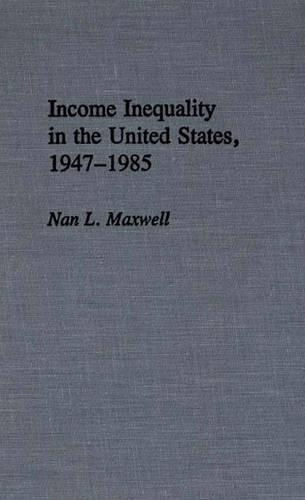
Income Inequality in the United States, 1947-1985
(Hardback)
Publishing Details
Income Inequality in the United States, 1947-1985
By (Author) Nan Maxwell
Bloomsbury Publishing PLC
Praeger Publishers Inc
8th December 1989
United States
Classifications
Tertiary Education
Non Fiction
Economic history
Society and Social Sciences
339.20973
Physical Properties
Hardback
227
Description
Using US Current Population Survey data from 1947 to 1985, Maxwell presents the results of a comprehensive study of the causes and consequences of the upturn in income inequality that took place during this period. By examining the impact of changing industrial and occupational employment, population age structure, household structure, female labour force participation, and government spending on social insurance, she systematically estimates and compares the influences on the inequality upturn. The book's findings reveal that the predominant influence on increasing income inequality is the changing economy, which has resulted in increased income at the top of the distribution and reduced income at the bottom. More specifically, the book shows that economic and demographic factors influenced income inequality by altering the composition of income-receiving units, altering the income distribution within each income-receiving unit type or within each race, and altering the relative income between income-receiving units and race.
Reviews
Income inequality has increased in recent years, but this phenomenon has not affected all groups the same way. Because the impact has varied for different segments of the population, basic questions arise about the causes of the changes in income distribution. Is middle-class income declining Does increased female participation in the labor force contribute to the inequality What is the likely income distribution of the future These questions reflect the scope of this study. To determine why income distribution has become less equal in recent years the author uses the theory and research extant in the field of income distribution to test the impact on income of variables from a variety of disciplines. Once these analyses are completed, the author sets out a public policy agenda designed to influence changes in labor supply and demand that would contribute to reducing income inequality and polarization. Maxwell's record of scholarly publications lends credibility to her analysis. Her policy prescriptions, which are a very small part of the final chapter, are subject to the same set of unrealistic assumptions as to feasibility as are everyone else's. Excellent bibliography. Upper-division and graduate readers.-Choice
This volume empirically analyzes trends in income distribution and income inequality in the United States from 1947 to 1985. Examines the impact of deindustrialization, population-age structure, female labor-force participation, and government spending on social insurance on income distribution. Argues that the largest contributor to increases in income inequality has been the shift from manufacturing to service sector employment while increased female labor-force participation and spending on social insurance have somewhat offset the trend toward greater inequality.-Economic Books
"This volume empirically analyzes trends in income distribution and income inequality in the United States from 1947 to 1985. Examines the impact of deindustrialization, population-age structure, female labor-force participation, and government spending on social insurance on income distribution. Argues that the largest contributor to increases in income inequality has been the shift from manufacturing to service sector employment while increased female labor-force participation and spending on social insurance have somewhat offset the trend toward greater inequality."-Economic Books
"Income inequality has increased in recent years, but this phenomenon has not affected all groups the same way. Because the impact has varied for different segments of the population, basic questions arise about the causes of the changes in income distribution. Is middle-class income declining Does increased female participation in the labor force contribute to the inequality What is the likely income distribution of the future These questions reflect the scope of this study. To determine why income distribution has become less equal in recent years the author uses the theory and research extant in the field of income distribution to test the impact on income of variables from a variety of disciplines. Once these analyses are completed, the author sets out a public policy agenda designed to influence changes in labor supply and demand that would contribute to reducing income inequality and polarization. Maxwell's record of scholarly publications lends credibility to her analysis. Her policy prescriptions, which are a very small part of the final chapter, are subject to the same set of unrealistic assumptions as to feasibility as are everyone else's. Excellent bibliography. Upper-division and graduate readers."-Choice
Author Bio
NAN L. MAXWELL is Associate Professor in the Department of Economics at California State University, Hayward. Her articles have been published in the American Economic Review, the American Journal of Economics and Sociology, the Journal of Economic Education, and the Southern Economic Journal.
